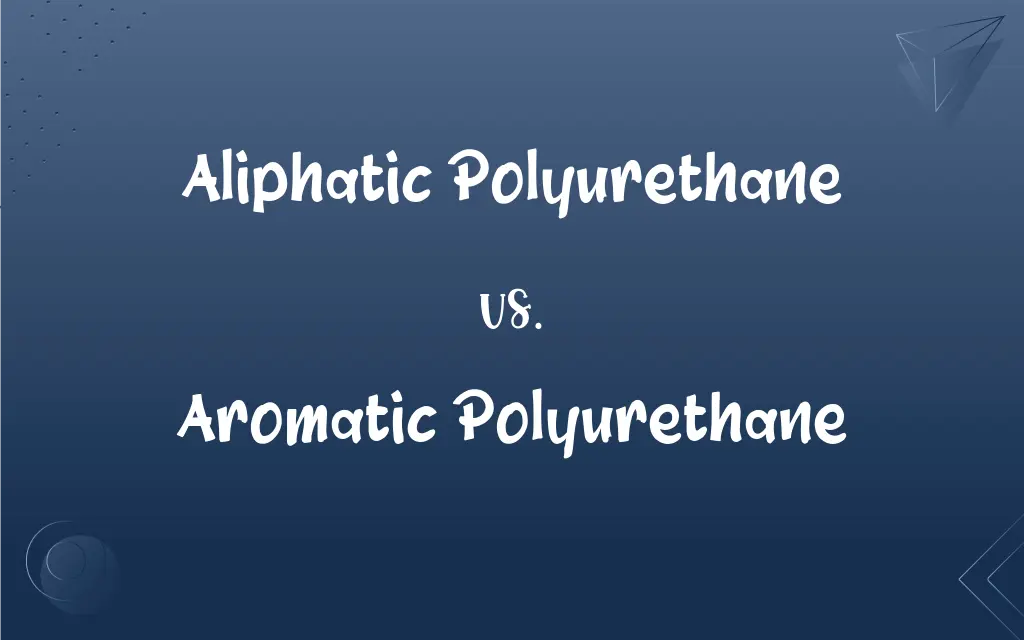Aliphatic Polyurethane vs. Aromatic Polyurethane: What's the Difference?
Edited by Aimie Carlson || By Janet White || Published on February 11, 2024
Aliphatic polyurethane is more UV-resistant and color-stable, while aromatic polyurethane is less UV-resistant but generally stronger and more economical.

Key Differences
Aliphatic polyurethane is characterized by its resistance to ultraviolet (UV) light and its ability to maintain color clarity over time. Aromatic polyurethane, on the other hand, tends to yellow and degrade under UV exposure, making it less suitable for outdoor applications.
In terms of mechanical properties, aromatic polyurethane often provides greater strength and hardness compared to aliphatic polyurethane. However, the latter's superior color stability and UV resistance make it preferable for applications where aesthetic appearance is crucial.
Aliphatic polyurethane finds widespread use in coatings, sealants, and paints where long-term color stability is essential. Aromatic polyurethane is commonly used in industrial applications where UV exposure is minimal, and durability is key.
Cost-wise, aromatic polyurethane is generally more economical than aliphatic polyurethane. This cost difference is a significant factor in choosing materials for various industrial and commercial applications.
Comparison Chart
UV Resistance
High resistance to UV light
Prone to yellowing under UV exposure
ADVERTISEMENT
Color Stability
Maintains color clarity over time
Less color stable, may yellow over time
Mechanical Properties
Generally softer and more flexible
Typically stronger and harder
Common Uses
Coatings, outdoor applications
Industrial applications with minimal UV exposure
Cost
More expensive
Generally more economical
Aliphatic Polyurethane and Aromatic Polyurethane Definitions
Aliphatic Polyurethane
Preferred for applications where appearance is critical.
The stadium seats were treated with aliphatic polyurethane to maintain their color.
ADVERTISEMENT
Aromatic Polyurethane
More economical than aliphatic polyurethane.
For cost-efficiency, the manufacturer used aromatic polyurethane in the product.
Aliphatic Polyurethane
Often used in high-quality paints and coatings.
For the exterior paint, the contractor recommended aliphatic polyurethane.
Aromatic Polyurethane
Commonly used in industrial settings with minimal UV exposure.
The machinery was coated with aromatic polyurethane for extra strength.
Aliphatic Polyurethane
Maintains color clarity, resisting yellowing.
Aliphatic polyurethane was chosen for the car's finish due to its color stability.
Aromatic Polyurethane
Prone to yellowing under UV light.
The company avoided aromatic polyurethane for the outdoor sign due to its UV sensitivity.
Aliphatic Polyurethane
UV-resistant polyurethane, ideal for outdoor use.
The outdoor furniture was coated with aliphatic polyurethane for durability.
Aromatic Polyurethane
Offers greater strength and hardness.
Aromatic polyurethane was used in the factory floor coating for its durability.
FAQs
What is aliphatic polyurethane?
A type of polyurethane known for its UV resistance and color stability.
What are the primary uses of aliphatic polyurethane?
Used in outdoor coatings, paints, and sealants.
How does UV exposure affect aliphatic polyurethane?
Aliphatic polyurethane resists yellowing and degradation under UV.
Which type of polyurethane is more color-stable?
Aliphatic polyurethane is more color-stable.
How does sunlight affect aromatic polyurethane?
Sunlight can cause it to yellow or degrade over time.
Why choose aliphatic over aromatic polyurethane for outdoor applications?
Aliphatic polyurethane remains color-stable and resists UV degradation.
Can aromatic polyurethane be used outdoors?
It's less ideal for outdoor use due to UV sensitivity.
Is aromatic polyurethane more durable than aliphatic?
Yes, it's generally stronger and harder.
What is aromatic polyurethane?
A type of polyurethane that is less UV-resistant but stronger and more cost-effective.
Why might a manufacturer choose aromatic polyurethane?
For its strength and cost savings in products not exposed to UV light.
Can aliphatic polyurethane be used indoors?
Yes, and its color stability is an advantage in well-lit areas.
What makes aromatic polyurethane economical?
It's less expensive to produce compared to aliphatic polyurethane.
Can aromatic polyurethane be used for floor coatings?
Yes, its strength makes it suitable for heavy-duty floor coatings.
Can aliphatic polyurethane be used for industrial applications?
Yes, especially where color stability and UV resistance are required.
What are the benefits of aromatic polyurethane in industrial settings?
Its strength and cost-effectiveness make it suitable for industrial use.
Is aliphatic polyurethane suitable for car finishes?
Yes, its UV resistance and color stability are ideal for car finishes.
How do the mechanical properties of these polyurethanes differ?
Aliphatic is generally softer and more flexible, while aromatic is harder and stronger.
Are there any downsides to using aliphatic polyurethane?
The main downside is its higher cost compared to aromatic types.
Is there a visual difference between the two types of polyurethane?
Aromatic polyurethane may yellow over time, unlike aliphatic.
Can either type of polyurethane be used in water-based formulations?
Yes, both types are available in water-based formulations for different applications.
About Author
Written by
Janet WhiteJanet White has been an esteemed writer and blogger for Difference Wiki. Holding a Master's degree in Science and Medical Journalism from the prestigious Boston University, she has consistently demonstrated her expertise and passion for her field. When she's not immersed in her work, Janet relishes her time exercising, delving into a good book, and cherishing moments with friends and family.
Edited by
Aimie CarlsonAimie Carlson, holding a master's degree in English literature, is a fervent English language enthusiast. She lends her writing talents to Difference Wiki, a prominent website that specializes in comparisons, offering readers insightful analyses that both captivate and inform.







































































